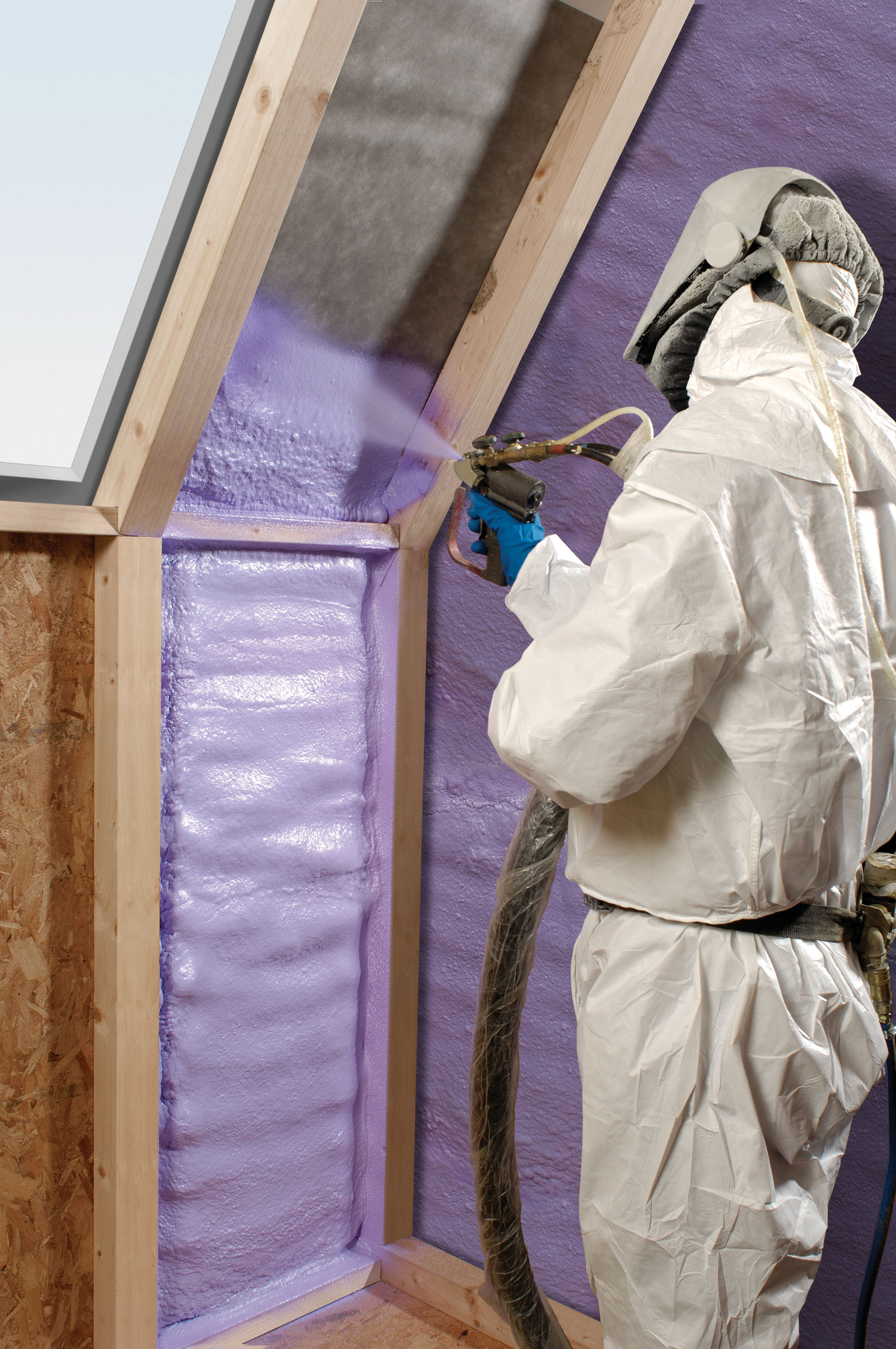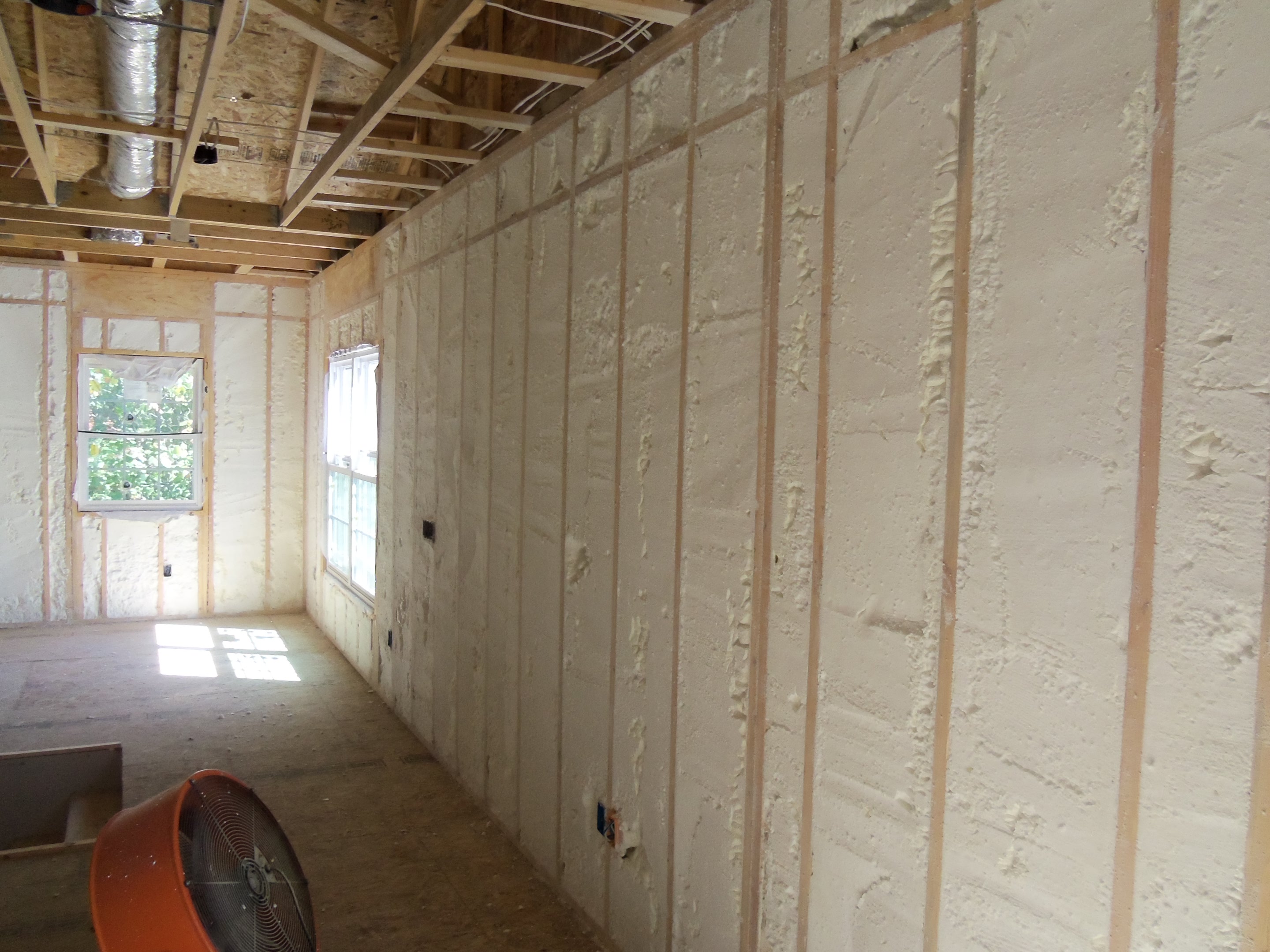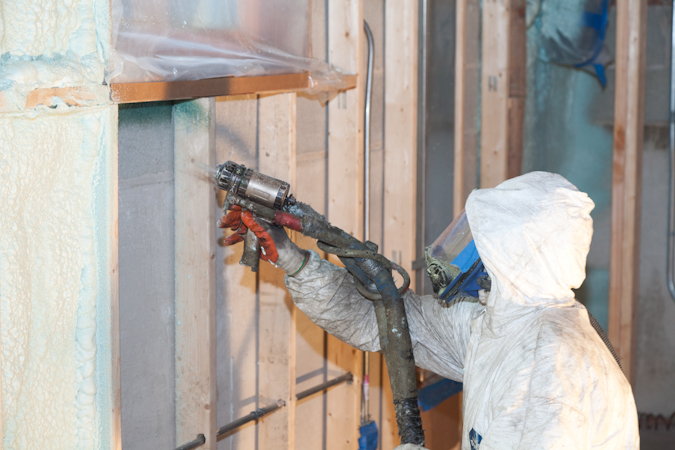Spray foams (insulation)
Mounting foam, often called foam insulation, insulating foam, filling or insulating foam, is a local foam that is used in the construction industry for sealing. One then speaks of " foaming ".
OCF is usually based on polyurethane, hence the name commonly used PU foam and PU foam. It sticks very well to many materials. It exists as a single-component foam ( 1K), or as two-component version ( 2K).
One-component PUR foam
This mounting foam is kept in aerosol cans in large quantities in pressure vessels. The foam is applied directly from the can. The processing is done with a hand dispenser or a dispenser. In 1- K- doses isocyanate and polyol are mixed in the manufacture in the can, then one speaks of a prepolymer. The doses need to be shaken before use to mix the components well. During foaming contents of the can react outside the box with the humidity or the moisture from the ground.
To accelerate this process and to achieve a better quality, it is recommended to spray before and after foaming the points ( the lands ) with water. The foams to cure from the outside, where the moisture acts first, inwardly from. After about 10 minutes, most foams are non-sticky and after about 45-60 minutes and can be cut. After three to five hours, they can be fully loaded. Make 1 -K cans in Germany with 80 percent of the lion's share of consumption.
Two-component PUR foam
2-component foams have another reactant: the so-called cross-linking agent or hardener. This is reflected as additional packaging unit either in the can or is specially supplied. Moistening for curing is not necessary here. The user must activate the hardener, as described on the tin. Uniformly colored foam shows the success of the mixing process. 2-component foams, in which the substances in the can react must be processed within the time period stated on the label. The 2-component foam reaches higher strengths than 1 -K foam and hardens very quickly and evenly. This simplifies the control of the curing process.
More PUR foams
A) Isocyanate foams
Polyurethanes (PU ) are a particularly versatile group of plastics for use in various areas of daily life. So PUR is as hard or soft foam in effective heat and cold insulation, furniture upholstery, car seats and mattresses. The versatile material has also also used as insulation of electrical or electronic components and can be found in modern high-performance coatings, but also in modern athletic shoes and floor coverings, again.
B) PUR foam variants
A isocyanatreduzierter foam is a foam in which the reactive chains in MDI ( methylene diphenyl diisocyanate ) to a value between 0.1 - were <1% reduced. Other foams are reduced so far in the MDI content that they have a value of < 0.1 % of reactive chains in MDI Moreover, there is mounting foams, although also contain the polyurethane backbone no free isocyanate groups, as these chemically in a preliminary stage were converted to the neutral urethane skeleton. The curing of the foams is based on reactive silane groups that lead to foaming out of the can by reaction with ambient moisture to crosslink and thereby curing of the applied foam.
Use
OCF serves as insulation and prevents air exchange through other leaks ( " thermal bridges ").
Application it is used for example in the window installation and door frames. Component foams are in the cured state resistant to water, oil, petrol, alkalis and various solvents, but not to UV radiation. The foam does not rot and rot- resistant. Very often polyurethane foam in the assembly of the door frame or the installation of windows is used. Here, the space between the wall and the door frame is selectively filled (for doors) with assembly foam. One problem with PU foam is that he still can swell greatly after application, but this can be prevented by appropriate processing or processing equipment. PU foam is used for insulation, filling, bonding and isolation and is filled with several hundred milliliters ( 300-750 ml) in Building Materials in doses available. 1K foam needs moisture to cure. This moisture comes in part from the surrounding materials (eg brick) and on the other from the air. In order to achieve the best possible result is an additional predampening the joint necessary, except in case of frost ( ice ), and is necessarily required by all manufacturers 1K foams. Most of the defects in the production of one-component PU foam joints due to insufficient humidity. 2K foam hardens in itself, without the action of moisture, as required for hardening components are already in the can and mixed during activation.
Through the use of special, signified as Zargenschaum OCF better sound insulation can be achieved with the installation of windows and doors in general. Most of these foams swell after less strong.
Well foam is intended for use in civil engineering to constantly damp places, such as for sealing of manhole rings.
Not yet dried, fresh foam can be removed with acetone or acetone-containing agents. Cured foam can only be removed mechanically.
Recycling
Used polyurethane foam cans are classified by law as hazardous waste ( hazardous waste) for recycling in Germany. This classification is necessary because even emptied PU foam cans still contain liquid residues. They may therefore only be disposed of via defined -back systems.
Individual doses are received free of charge by the local waste disposal companies. Many hardware stores will take back used mounting foam cans. The consumers of large amounts may also call the respective licensors, announce their quantities (usually via a freephone number) and provide for a free pickup. The respective licensors, be recognized by the logo on the PUR foam can.
The redemption will be made on the basis of § 25 Recycling Act ( KrWG ) in conjunction with § 8 of the Ordinance. Thus 23 ( product stewardship ), the manufacturers are coming out of the KrWG according to §.
Risk Bauschaum
Isocyanates as the main components of OCF apply for a long time as a risk substances because they can cause eg eye, skin and respiratory irritation. In recent studies, these substances are even suspected to cause cancer. All construction foams, containing more than 1 % of free isocyanate - usually diphenylmethane diisocyanate ( = methylene diphenyl diisocyanate, MDI for short ) - included, must therefore since December 2010 with reference ( R40 of R-phrases ) " evidence of a carcinogenic effect " are marked. The products marked with an asterisk may be sold in accordance with German Chemicals Prohibition Ordinance to private customers only by competent personnel. Thus, they may no longer be freely available in hardware stores, but for example, must be locked away in a glass case.
Exceptions to this rule are construction foams that are based on the so-called Alpha technology. In these foams, the free isocyanates are chemically reacted completely already in the production of foam cans with specific alpha- silanes. The doses of alpha- expanding foam be sprayed just as the conventional PU foams and need for curing even humidity. Since they are completely free of isocyanates, the alpha- Bauschaumdosen no gloves must be settled. If the foam accidentally gets on your skin, it can simply be rubbed off easily and does not leave the typical PU foams black spots. In the crosslinking of the foam produced methanol.
If 1K Bauschaum processed without aeration in small confined spaces, the LPG (propane -butane mixture ) ranges from a few cans of 750 ml, to form together with the room air to form an explosive gas mixture. Sparks of light switches and brush fire of drilling machines, vacuum cleaners and the like are sufficient for ignition of the gas.









